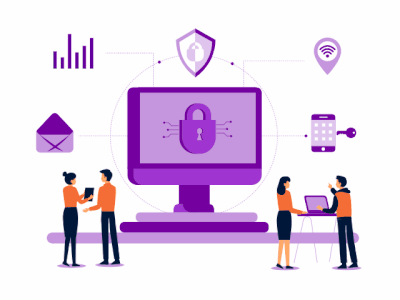The Evolving Landscape of Cybersecurity

As technology advances, so do the threats posed by cybercriminals. Understanding the evolving cybersecurity landscape is critical for organizations and individuals alike to protect their valuable digital assets.
Cybersecurity has become an increasingly critical concern in today's digital age. With the rapid expansion of digital transformation across industries, the attack surface for potential threats has grown exponentially. As organizations and individuals continue to rely on technology for their daily operations, the importance of robust cybersecurity measures cannot be overstated.
This article explores the current cybersecurity landscape, highlighting emerging threats, best practices for protection, and the future challenges we're likely to face as technology continues to evolve.
The Growing Threat Landscape
The cybersecurity threat landscape is constantly evolving, with attackers developing increasingly sophisticated methods to breach systems and compromise data. Some of the most significant current threats include:
Advanced Persistent Threats (APTs)
Sophisticated, targeted attacks conducted by well-funded and highly skilled adversaries who maintain unauthorized access to systems over extended periods, often with the goal of espionage or data theft.
Phishing Attacks
Deceptive attempts to steal sensitive information like usernames, passwords, and credit card details by disguising as trustworthy entities in electronic communications. These attacks have become more targeted and sophisticated with spear-phishing and whaling techniques.
Ransomware
Malicious software that encrypts victims' data, with attackers demanding payment for decryption. Ransomware attacks have evolved to include double extortion tactics, where attackers threaten to publish stolen data if ransom isn't paid.
Data Breaches
Security incidents where sensitive, protected, or confidential information is accessed, stolen, or exposed by unauthorized individuals. These breaches can result in significant financial losses, regulatory penalties, and reputational damage.
Key Cybersecurity Best Practices
Protecting against cyber threats requires a multi-layered approach that addresses people, processes, and technology. Here are some essential cybersecurity best practices that everyone should follow:
Strong Passwords
Use unique, complex passwords for different accounts and implement multi-factor authentication (MFA) wherever possible. Consider using a reputable password manager to securely store and generate strong passwords.
Regular Software Updates
Keep all software, operating systems, and applications up-to-date with the latest security patches. Outdated software often contains vulnerabilities that can be exploited by attackers.
Beware of Phishing Attacks
Be skeptical of unsolicited emails, messages, or phone calls asking for sensitive information. Verify the sender's identity before clicking on links or downloading attachments, and hover over links to check their actual destination.
Use Two-Factor Authentication (2FA)
Enable 2FA or multi-factor authentication whenever possible, adding an extra layer of security beyond just a password. This typically combines something you know (password) with something you have (like a mobile device) or something you are (biometrics).
Secure Wi-Fi Networks
Ensure your Wi-Fi networks are secure with strong encryption (WPA3 if available), complex passwords, and unique SSIDs. Avoid using public Wi-Fi networks for sensitive transactions or consider using a VPN when connecting to public networks.
Back Up Your Data
Regularly back up important data using the 3-2-1 rule: keep at least three copies of your data on two different storage media with one copy stored off-site or in the cloud. This helps ensure recovery in case of ransomware or other data loss incidents.
Be Mindful of Social Engineering
Be aware that attackers often manipulate people into breaking security procedures or revealing sensitive information. Verify requests for sensitive information or unusual actions, especially if they create a sense of urgency or fear.
Use Security Software
Install and maintain reputable antivirus, anti-malware, and firewall software on all devices. Keep these tools updated to protect against the latest threats and consider using advanced solutions like Endpoint Detection and Response (EDR) for organizations.
Stay Informed
Keep up with the latest cybersecurity news, threats, and best practices. Subscribe to security bulletins relevant to your industry and consider security awareness training for yourself and your team to stay vigilant against evolving threats.
Emerging Threats and Future Challenges
As technology advances, the cybersecurity landscape continues to evolve. Here are some emerging threats and future challenges to be aware of:
AI-Powered Attacks
Artificial intelligence and machine learning are being leveraged by attackers to develop more sophisticated attack vectors, automate attacks, and evade traditional security measures. These technologies can be used to create convincing deepfakes, automate social engineering attacks, and discover new vulnerabilities.
IoT Security
The proliferation of Internet of Things (IoT) devices introduces new security challenges due to their often limited security features and increased connectivity. These devices can create new entry points for attackers and potentially be leveraged for botnets or other malicious purposes.
Cloud Security
As more organizations migrate to cloud environments, securing these ecosystems becomes increasingly important. Misconfigurations, inadequate access controls, and shared responsibility confusion can all lead to security vulnerabilities in cloud deployments.
Conclusion
Cybersecurity is no longer optional in our increasingly connected world. It requires a proactive, multi-layered approach that evolves alongside the threat landscape. By understanding current threats, implementing robust security measures, and staying informed about emerging risks, individuals and organizations can significantly reduce their vulnerability to cyber attacks.
Remember that cybersecurity is not just about technology—it's also about people and processes. Creating a security-conscious culture and implementing strong security policies are just as important as deploying the latest security tools.
By adopting the cybersecurity best practices outlined in this article and remaining vigilant against evolving threats, you can better protect your digital assets and sensitive information in this ever-changing cybersecurity landscape.
How have you improved your cybersecurity practices recently? Share your insights or questions!
